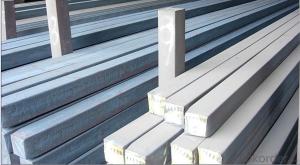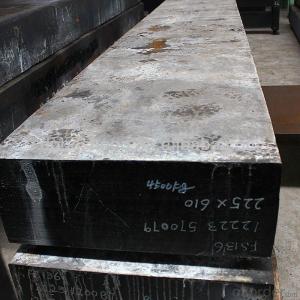Square Steel Billet Q235 Grade Prime Quality 5#
- Loading Port:
- Tianjin
- Payment Terms:
- TT OR LC
- Min Order Qty:
- 2000 m.t
- Supply Capability:
- 50000 m.t/month
OKorder Service Pledge
OKorder Financial Service
You Might Also Like
Description of Square Steel Billet Q235 Grade Prime Quality 5#
M. S. Billets are used for rolling of TMT Re-Bars of Fe415 and Fe500 Grade and various other structural steel products.
CRS Billets are used for rolling of CRS TMT Re-Bars.
Special Alloy Billets are used for rolling of any special grade TMT Re-Bars like Earthquake resistant TMT Re-Bars and for special grade structural steel products.
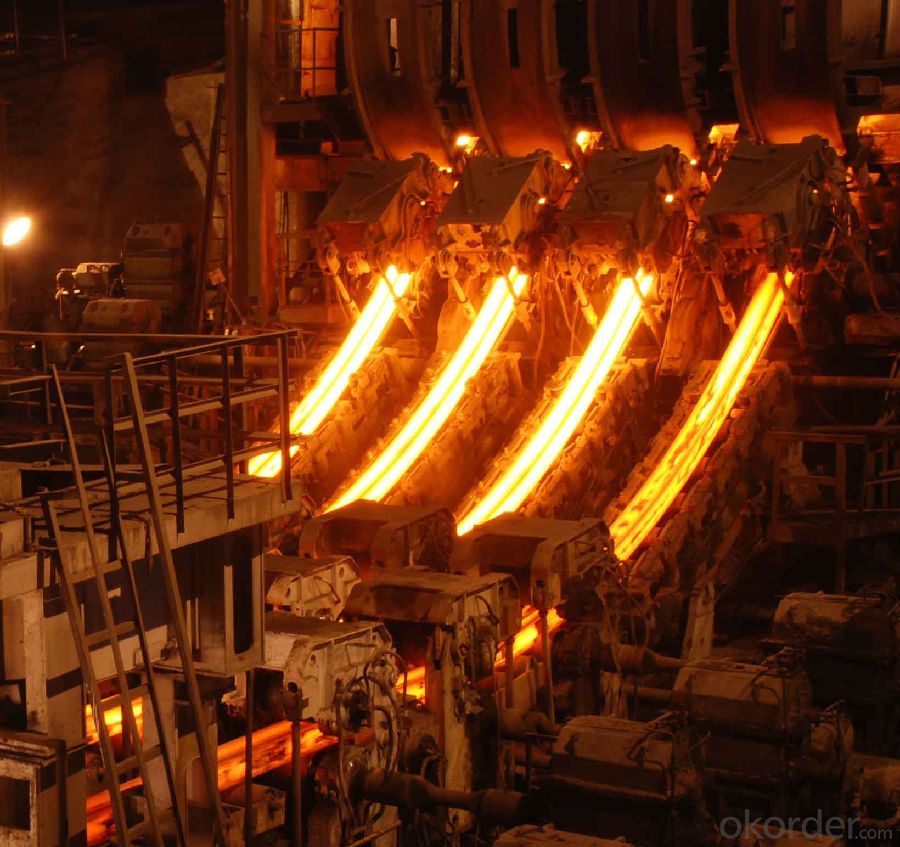
Main Feature Square Steel Billet Q235 Grade Prime Quality 5#
Raw elements(C,Fe,Ni,Mn,Cr,Cu.)---Smelted ingots by AOD finery---hot rolled into black suface---pickling in acid liquid---cold drawn----polished by automatically machine--- cutting into pieces---checking quanlity
Applications of Square Steel Billet Q235 Grade Prime Quality 5#
Widely Used in the areas such as Stainless Steel Fasteners, Chains, Kitchen and Sanitary wares, Furniture handles, Handrails, Electroplating and Electrolyzing pendants, Foods, Electron, Petroleum, Construction and Decoration, etc. Products have a high strength after cold-working. Electronic products parts, Medical appliance, Springs, Bus Inside and Outside packaging and building, Street Lamp Posts, etc. Decoration materials and Outdoor Publicity Billboard. Used for the products which have the Anti-Stress Corrosion requirement. Electron Products, Table-wares, Bolts, Nuts, Screen Meshes, Cumbustors and so on.
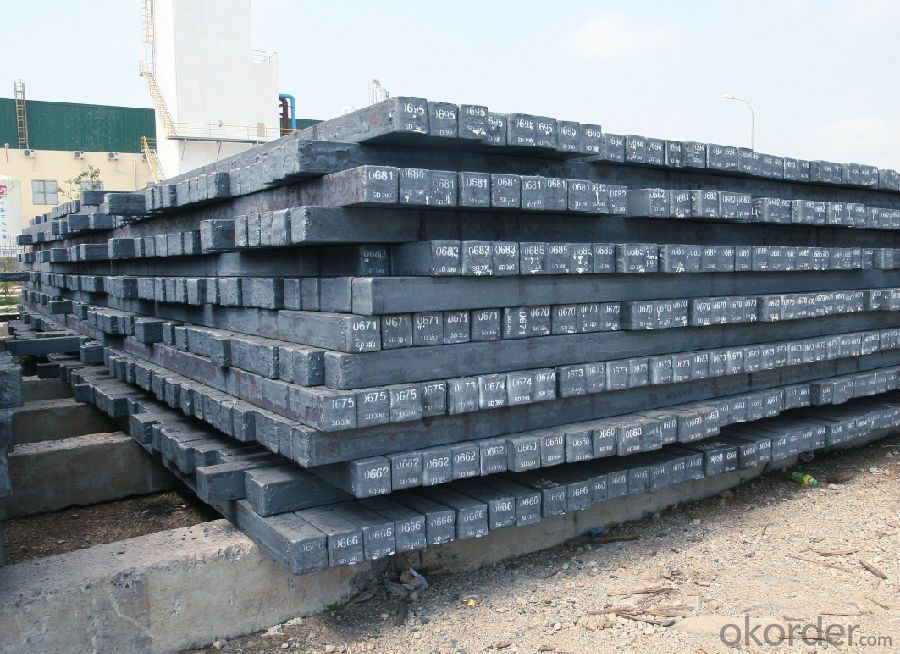
Specifications of Square Steel Billet Q235 Grade Prime Quality 5#
| Standard | C(%) | Mn(%) | S(%) | P(%) | Si(%) |
| Q195 | ≤0.12 | ≤0.50 | ≤0.040 | ≤0.035 | ≤0.30 |
| Q235 | ≤0.20 | ≤1.40 | ≤0.045 | ≤0.045 | ≤0.35 |
| Q275 | ≤0.22 | ≤1.50 | ≤0.045 | ≤0.045 | ≤0.35 |
| 20MnSi | 0.17-0.25 | 1.2-1.6 | ≤ 0.050 | ≤ 0.050 | 0.40-0.80 |
| 3SP | 0.14-0.22 | 0.40-0.85 | ≤ 0.050 | ≤ 0.040 | 0.05-0.15 |
| 5SP | 0.28-0.37 | 0.50-1.00 | ≤ 0.050 | ≤ 0.040 | 0.15-0.30 |
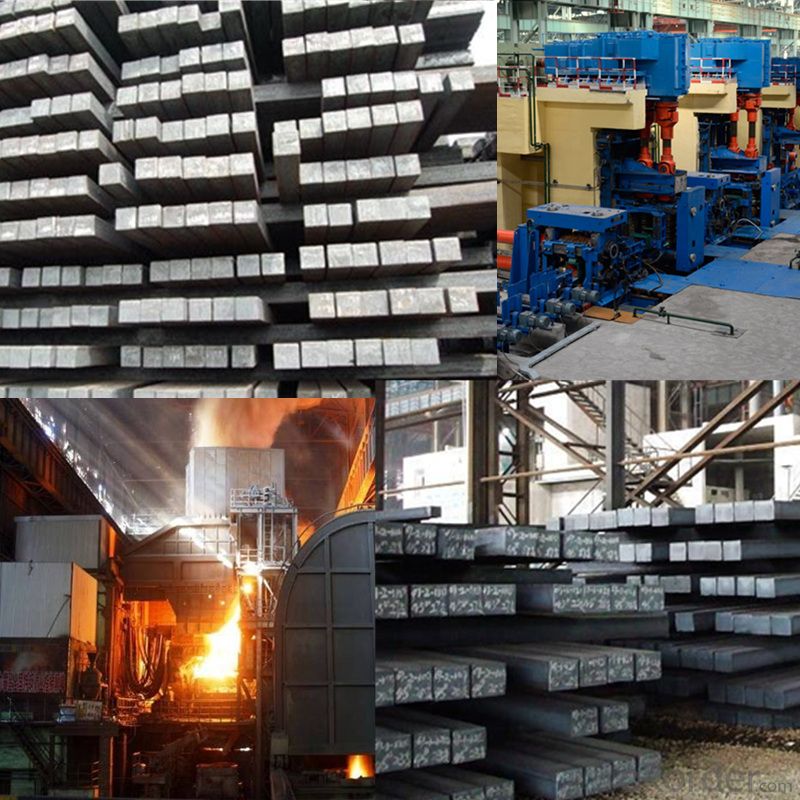
FAQ of Square Steel Billet Q235 Grade Prime Quality 5#
We have organized several common questions for our clients,may help you sincerely:
1. How Can I Visit There?
Our company is located in Tianjin City, China, near Beijing. You can fly to Tianjin Airport Directly. All our clients, from home or aboard, are warmly welcome to visit us!
2. How Can I Get Some Sample?
We are honored to offer you sample.
3. Why choose CNBM?
Our delivery time about 15-20days for standard sizes, if you have other requirements like hardness, quanity and width ,it is about 20-40days. But don't worry we also try our best for the delivery time ,because time longer and our cost is higher.
- Q:How are steel billets inspected for quality?
- Steel billets are typically inspected for quality using various non-destructive testing methods such as visual inspection, ultrasonic testing, magnetic particle inspection, and dye penetrant testing. These tests help identify any surface defects, cracks, or internal flaws in the billets, ensuring that they meet the required quality standards before further processing.
- Q:What are the potential applications of steel billets in the mining industry?
- Steel billets have a wide range of potential applications in the mining industry. Firstly, steel billets can be used in the construction of mining equipment and machinery. These billets can be shaped and welded to form various components such as frames, supports, and chassis for heavy mining machinery. The strength and durability of steel make it an ideal material for withstanding the harsh conditions and heavy loads encountered in mining operations. Secondly, steel billets can be utilized in the fabrication of conveyor belts, which are essential for the transportation of bulk materials in mines. The high tensile strength of steel ensures that the conveyor belts can withstand the weight of the material being transported, as well as the continuous movement and impact from the mining process. Additionally, steel billets can be employed in the construction of underground support systems, such as mine shafts and tunnels. These structures require strong and reliable materials to ensure the safety of workers and the integrity of the mining operation. Steel billets can be used to manufacture support beams, rods, and plates, providing the necessary stability and reinforcement. Moreover, steel billets can be used in the production of wear-resistant components, such as grinding balls and liners, which are crucial in mineral processing. These components are used in grinding mills to crush and grind the ore, and the abrasion-resistant properties of steel make it a suitable material for this application. By using steel billets, mining companies can enhance the efficiency and longevity of their mineral processing operations. Overall, the potential applications of steel billets in the mining industry are extensive. From equipment manufacturing and conveyor belt fabrication to underground support systems and wear-resistant components, steel billets play a vital role in improving the productivity, safety, and efficiency of mining operations.
- Q:How do steel billets contribute to the chemical industry?
- Steel billets are an essential raw material in the chemical industry for the production of various chemicals and chemical products. These billets, which are solid bars or rods of steel, play a crucial role in the manufacturing process. Firstly, steel billets are used in the construction of reactors and vessels that are used in chemical production plants. These reactors are designed to withstand high temperatures and pressure, and steel billets provide the necessary strength and durability for these applications. The chemical reactions that take place in these reactors often involve corrosive or harsh chemicals, and the use of steel billets ensures that the equipment remains intact and prevents any leaks or accidents. Furthermore, steel billets are also used in the production of catalysts, which are substances that facilitate chemical reactions without being consumed in the process. Many catalysts are made from metals or metal oxides, and steel billets are often used as the base material for their production. By providing a stable and strong foundation, steel billets help ensure the efficiency and effectiveness of these catalysts. Additionally, steel billets are used in the construction of pipelines and storage tanks that are crucial for transporting and storing chemicals. These structures need to be able to withstand high pressures and corrosive environments, and steel billets are the preferred material due to their strength, durability, and resistance to chemical degradation. They ensure the safe and efficient transportation and storage of chemicals, which is crucial for the chemical industry. In conclusion, steel billets are indispensable in the chemical industry due to their strength, durability, and resistance to chemical degradation. They are used in the construction of reactors, vessels, catalysts, pipelines, and storage tanks, all of which are essential components of chemical production and transportation. Without steel billets, the chemical industry would struggle to operate efficiently and safely.
- Q:How are steel billets used in the production of construction parts?
- Steel billets are an important raw material in the production of construction parts. They are essentially semi-finished steel products that are cast into square or rectangular shapes. These billets are then further processed and transformed into various construction components like beams, columns, rods, and bars. The first step in utilizing steel billets is heating them in a furnace to a temperature that allows for easy deformation and shaping. Once the billets reach the desired temperature, they are passed through a series of rolling mills, where they undergo hot rolling. This process involves repeatedly passing the billets through multiple pairs of rollers to gradually reduce their size and shape them into the required form, such as beams or rods. Hot rolling not only helps to shape the billets but also improves their mechanical properties, such as strength, toughness, and ductility. The resulting steel products are then cut to the desired lengths and further processed, if necessary, to meet specific construction requirements. These steel components made from billets are widely used in construction projects. For instance, beams made from steel billets are commonly used to provide structural support in buildings and bridges. They offer superior strength and load-bearing capacity, making them ideal for withstanding heavy loads and ensuring the overall stability of the structure. Steel rods and bars, on the other hand, are widely used in reinforced concrete construction. These components are embedded within the concrete to increase its tensile strength and prevent cracks from forming. They are essential in the construction of foundations, slabs, walls, and other structural elements that require added reinforcement. In summary, steel billets play a crucial role in the production of construction parts by serving as the starting point for the manufacturing process. Through hot rolling and subsequent processing, these billets are transformed into various steel components that are used to provide structural support, reinforcement, and durability in construction projects.
- Q:How are steel billets used in the manufacturing of marine components?
- Due to their strength, durability, and versatility, steel billets are indispensable raw materials utilized in the production of marine components. Essentially, steel billets are semi-finished steel products that are cast into specific shapes, typically squares or rectangles, via continuous casting. These billets serve as the initial stage for a variety of marine components. Hot rolling is a primary method employed in the manufacturing of marine components using steel billets. In this process, the steel billet is heated to high temperatures and then passed through a series of rollers to shape it into the desired form. This can involve transforming the billet into rods, bars, beams, or other structural shapes commonly utilized in marine applications. Forging is another technique employed in the manufacturing of marine components using steel billets. This process involves heating the billet to high temperatures and subsequently applying pressure to shape it into the desired form. Forging is commonly employed to manufacture marine components such as propeller shafts, crankshafts, and other high-strength parts that necessitate precise shaping and exceptional mechanical properties. Furthermore, steel billets can be utilized in the manufacturing of marine components through the process of machining. Machining entails the removal of material from the billet using various cutting tools to create intricate shapes and features. This method is commonly employed to produce marine components such as valves, fittings, and other precision parts that require meticulous tolerances and intricate designs. In conclusion, steel billets play a pivotal role in the manufacturing of marine components. Their strength, durability, and versatility make them an ideal raw material for producing various marine parts through processes such as hot rolling, forging, and machining. By utilizing steel billets, manufacturers can ensure that the marine components they produce are capable of withstanding the harsh conditions and demanding requirements of the marine environment.
- Q:What are the different types of cutting techniques used for steel billets?
- Different cutting techniques are employed for steel billets, depending on the specific requirements of the project. Several commonly used techniques include: 1. Sawing: This traditional and widely utilized method involves cutting through the steel billet using a saw blade. It can be done manually or with automated sawing machines, making it suitable for both small and large billets. 2. Flame Cutting: Also known as oxy-fuel cutting, this technique employs a flame torch to heat the steel to its kindling temperature. Then, a jet of oxygen is introduced to burn through the metal. It is frequently used for cutting thicker billets and can be performed manually or with CNC-controlled equipment. 3. Plasma Cutting: By utilizing a high-velocity jet of ionized gas, plasma cutting melts and blows away the steel. This technique is particularly effective for cutting billets with complex shapes or contours. It is often automated and produces clean and precise cuts. 4. Waterjet Cutting: This technique involves the use of a high-pressure jet of water combined with abrasive particles to cut through the steel billet. It is ideal for materials sensitive to heat, as it minimizes heat-affected zones. Waterjet cutting is capable of handling various thicknesses and shapes of billets. 5. Laser Cutting: Laser cutting employs a high-powered laser beam to melt and vaporize the steel, resulting in a clean and precise cut. It is highly accurate and suitable for cutting intricate shapes and designs. Laser cutting is commonly automated and widely used in industrial settings. Factors such as desired precision, speed, material thickness, and budget must be considered when selecting the most appropriate cutting technique for steel billets. Each technique has its own advantages and limitations, and choosing the right one can significantly impact the quality and efficiency of the cutting process.
- Q:Is the reaction of carbon and carbon dioxide a redox reaction?
- Is the redox reflect the oxidizing agent is CO2 C 2009-10-22, the reducing agent is the oxidizing agent is CO2, is C 2009-10-22 reductant is redox reaction. Price reduction in carbon dioxide carbonation, was reduced, so is the oxidant.
- Q:What is the role of steel billets in the manufacturing of tools and dies?
- Steel billets play a crucial role in the manufacturing of tools and dies. These billets, which are essentially semi-finished steel products, serve as the starting material for the production process. They are heated, forged, and shaped into the desired form to create tools and dies that are used in various industries. One of the main advantages of using steel billets is their high strength and durability. Steel is known for its excellent mechanical properties, including hardness, toughness, and wear resistance. By using billets made from high-quality steel, manufacturers can ensure that the resulting tools and dies will have the necessary strength and durability to withstand the demanding conditions of their intended applications. Additionally, steel billets offer versatility in terms of customization. They can be easily shaped and formed into different sizes and dimensions, allowing manufacturers to create tools and dies that meet specific requirements. Whether it is a complex mold or a precision cutting tool, steel billets provide the flexibility needed to produce intricate and accurate components. Furthermore, steel billets are preferred in the manufacturing of tools and dies due to their thermal conductivity. Steel has the ability to conduct heat effectively, which is essential for processes such as heat treatment, quenching, and tempering. These thermal treatments are often employed to enhance the hardness and strength of tools and dies, making them more resistant to wear and prolonging their lifespan. In summary, the role of steel billets in the manufacturing of tools and dies is indispensable. They serve as the primary material from which these components are produced, offering high strength, durability, customization options, and thermal conductivity. By utilizing steel billets, manufacturers can create tools and dies that meet the demanding requirements of various industries, ensuring optimal performance and longevity.
- Q:What is the chemical composition of steel billets?
- Steel billets typically contain iron as the primary element, along with varying amounts of carbon, manganese, silicon, sulfur, and phosphorus, which make up its chemical composition. The specific grade and intended use of the steel billets determine the exact composition, which may vary. Carbon, in small quantities ranging from 0.02% to 0.5%, is included to enhance the steel's strength and hardness. Manganese is commonly added to improve toughness and hardenability, while silicon aids in deoxidizing the metal and increasing its strength. Sulfur and phosphorus, impurities that can adversely affect the steel's mechanical properties, are typically kept at low levels. Furthermore, chromium, nickel, molybdenum, and other elements may be added in small amounts to enhance specific properties such as corrosion resistance or high-temperature strength.
- Q:Can steel billets be used for marine applications?
- Yes, steel billets can be used for marine applications. Steel billets are often used as a raw material for various marine components and structures. Due to their high strength and durability, steel billets are well-suited for marine applications that require resistance to corrosion, impact, and harsh environmental conditions. They can be used to manufacture ship hulls, propeller shafts, marine pipelines, offshore platforms, and other marine structures. Additionally, steel billets can be further processed and shaped into desired forms to meet specific requirements for marine applications.
1. Manufacturer Overview |
|
|---|---|
| Location | |
| Year Established | |
| Annual Output Value | |
| Main Markets | |
| Company Certifications | |
2. Manufacturer Certificates |
|
|---|---|
| a) Certification Name | |
| Range | |
| Reference | |
| Validity Period | |
3. Manufacturer Capability |
|
|---|---|
| a)Trade Capacity | |
| Nearest Port | |
| Export Percentage | |
| No.of Employees in Trade Department | |
| Language Spoken: | |
| b)Factory Information | |
| Factory Size: | |
| No. of Production Lines | |
| Contract Manufacturing | |
| Product Price Range | |
Send your message to us
Square Steel Billet Q235 Grade Prime Quality 5#
- Loading Port:
- Tianjin
- Payment Terms:
- TT OR LC
- Min Order Qty:
- 2000 m.t
- Supply Capability:
- 50000 m.t/month
OKorder Service Pledge
OKorder Financial Service
Similar products
New products
Hot products
Related keywords

